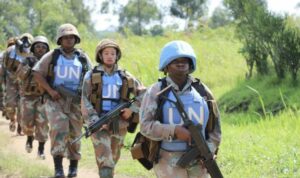August has arrived! As the the buzzing summer comes to an end, the students of FerMUN prepare to dive back into the sea of diplomacy , exchanging their swimming suits for conference suits as they await the return of weekly MUN sessions in September. Apart from the chairs who spent much time researching and preparing for the debates, most students took a short vacation from the diplomatic world. To ease their return and remind everyone about the importance of the UN, we have prepared a collection of interesting case studies which highlight the importance of global cooperation and compromise in the goal of achieving peace.
“The United Nations was not created to take mankind to heaven, but to save humanity from hell” . This quote, pronounced by Dag Hammarskjöld, the second Secretary-General of the United Nations, perfectly captures the role of the UN in our contemporary world. It is important to recognize that despite ongoing wars, violence and conflicts, the UN remains an irreplaceable pillar in ensuring security and justice . Without further ado, lets open up our history books and look at how the UN helped the following three nations to establish peace.
Guatemala, 1997
This Central-American republic endured 36 years of brutal civil war fought between left-wing groups, notably the Unidad Revolucionaria Nacional Guatemalteca (UNRG), and the right-wing military dictatorship and later elected government. Violence reigned during these decades as 200 000 Guatemalan lives were lost and numerous human rights and international laws were violated by both sides. The UN intervened in 1994 to support the several peace accords signed by the UNRG and the government. They deployed human rights monitors, legal experts and police all over the country to de-escalate violence while they assured ethical negotiations between the two groups for more permanent peace agreements over the course of the next three years. This permanent peace was finally achieved in 1997, when the UNRG guerillas demobilised , as demanded by the permanent peace accords signed in 1996 . Thanks to the cooperation promoted by the UN , a permanent ceasefire was signed in Oslo (fourth December 1996) as well as an Agreement on a Firm and Lasting Peace , which was signed in Guatemala city ( twenty-ninth December 1996) .
Sierra Leone, 2002
Lasting a decade, the civil war in Sierra Leone was a violent and dividing conflict for the people of the west-african nation. The rebel group Revolutionary United Front (RUF) initiated an armed rebellion against the government in 1991 and tensions rose to an all time high as they captured the capital, Freetown, in 1997. The Economic Community of West African States (ECOWAS) was deployed instantly to host negotiations , which resulted in the Lomé Peace Accord being signed by the rebel group and the government in Togo in 1999. To guarantee peace as well as the de-armament of combat groups, the United Nations Mission in Sierra Leone (UNAMSIL) was called upon to deploy for a peacekeeping operation. This operation encountered many difficulties, as the RUF continued to resist disarmament and continued the conflict. In 2000, the Security Council declared that the RUF was the cause of the continuing conflict and UNAMSIL declared its support for the Government of Sierra Leone in its campaign against the RUF. A permanent ceasefire was finally signed in November 2000 as the Sierra Leonien army , alongside British and UNMSIL troops, forced the RUF to negotiate. The next year , a large-scale Disarmament, Demobilisation, and Reintegration process occurred and the war which took 70 000 lives and mutilated 20 000, was officially declared over in 2002.
El Salvador, 1992
The Salvadoran civil war lasted 12 years as the Salvadoran government fought against the Frente Farabundo Martí para la Liberación Nacional (FMLN), a coalition of left-wing rebel groups. After 10 years of brutal civil war which took 75 000 lives, both parties formally requested that the UN help with peace negotiations aimed to end the violent conflict. Within a year, an accord was signed by both groups to ensure respect for human rights and the security council established the United Nations Observer Mission in El Salvador (ONUSAL) to see over the correct execution of this agreement. The ONUSAL was also called upon a year later to monitor the implementation of the Peace Agreements of January 1992, which were organised by the Secretary general and put a definitive end to the conflict which spanned more than a decade.
Hopefully, these case studies have been interesting to read about!
These examples allow us to learn more about a country’s history of peace and war , and learn more about the UN’s diverse strategies to achieve peace in different parts of the world.
Marta Prokopchuk
